The take away for this teachable explore more is that I want you to remember medications that are on medication list, and what are they for, what are the side effects are and contraindications, and nursing consideration for each medication that is on that list.
Now, let us do a little review of autonomic nervous system. It is divided into parasympathetic and sympathetic nervous systems. The adrenergic drugs are going to stimulate the sympathetic nervous system. They are known as adrenergic agonists or sympathomimetics. Cholinergic medication acts on the parasympthatic nervous system. The other nerve transmitter acetylcholine.
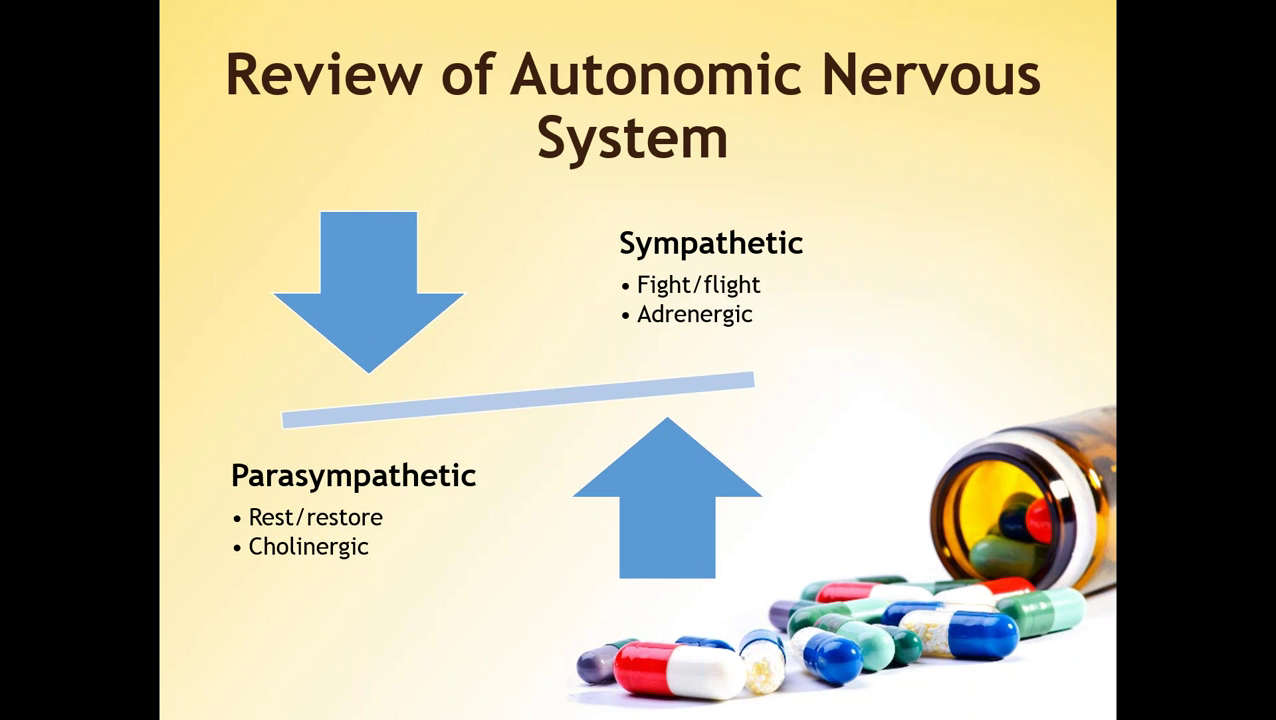
There are two types of cholinergic receptors, nicotinic and mascarinic receptors. Adrenergic receptors are responsible for stimulating the sympathetic nervous system with the aid of norepinephrine.
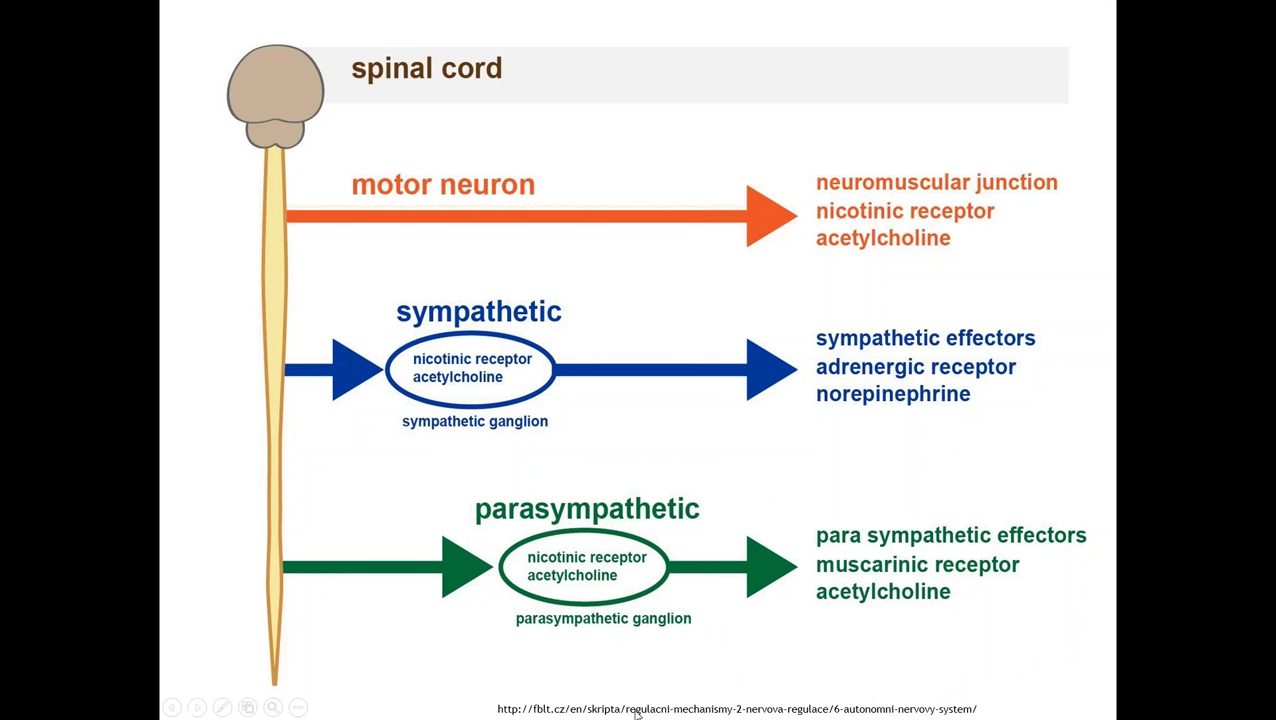
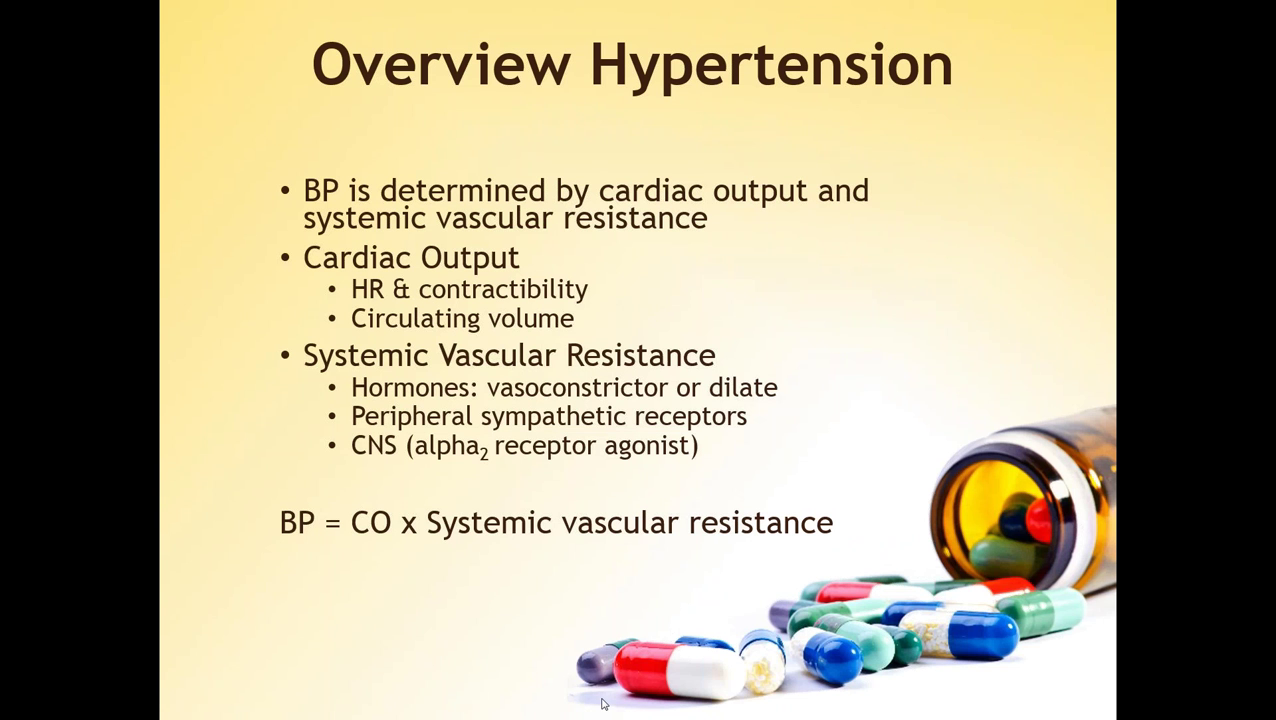
Your blood pressure is determined by cardiac output and systemic vascular resistance. Cardiac output is the amount of blood that is ejected from the left ventricles. Systemic vascular resistance is the resistance to the blood flow determined by the diameter of the blood vessel. The blood pressure is regulated by the heart rate, contraction of the heart, the amount of blood circulating as well as the whole amount. 90% of hypertension is called essential hypertension, and is idiopathic. Secondary hypertension is most often caused by other diseases such as renal disease, thyroid disease, and diabetes. Dilation of blood vessels and a decrease in blood volume are going to be the main goal of treating hypertension.
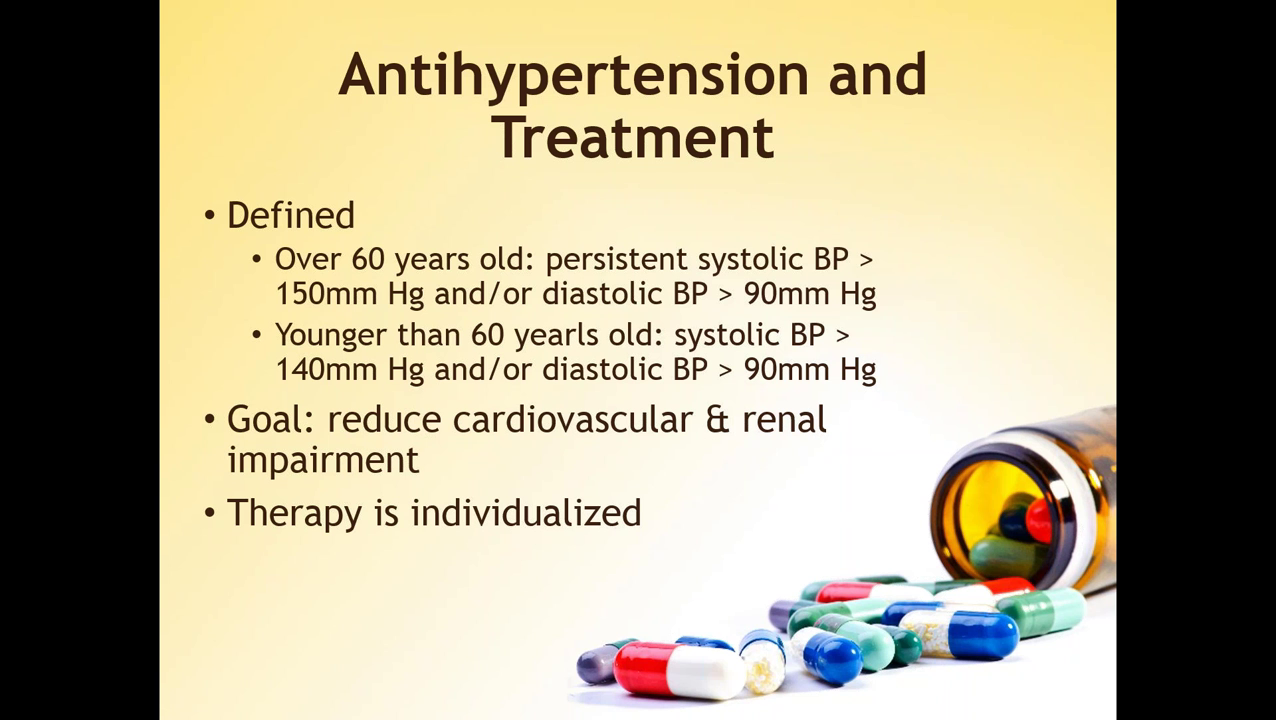
Hypertension is defined as systolic blood pressure greater than 140mmHg and/or diastolic pressure greater than 90mmHg for those less than 60 years of age. Also, hypertension is systolic BP greater than 150mmHg and/or diastolic BP greater than 90mmHg for those over 60 years of age, and for those with chronic kidney disease or diabetes. The goal of treating hypertension is to decrease cardiovascular and renal impairment. Drug therapy needs to be individualized depending on genetic factors and co-existing impairments, as well as the impact the disease has on quiet quality of life.
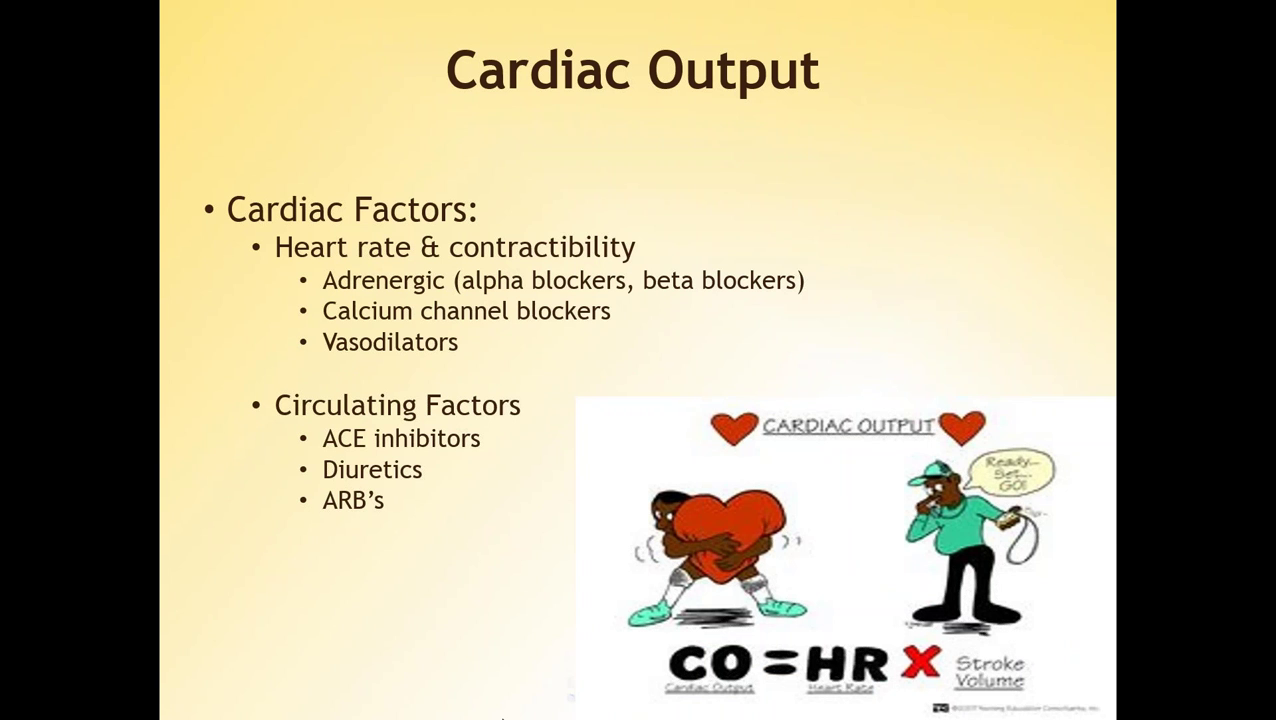
Adrenergic drugs, calcium channel blockers, vasodilators are going to assist in decreasing the heart rate and contractility of the heart. ACE inhibitors, diuretics, and ARB’s are going to affect the circulating blood.
There are five different categories of adrenergic drugs
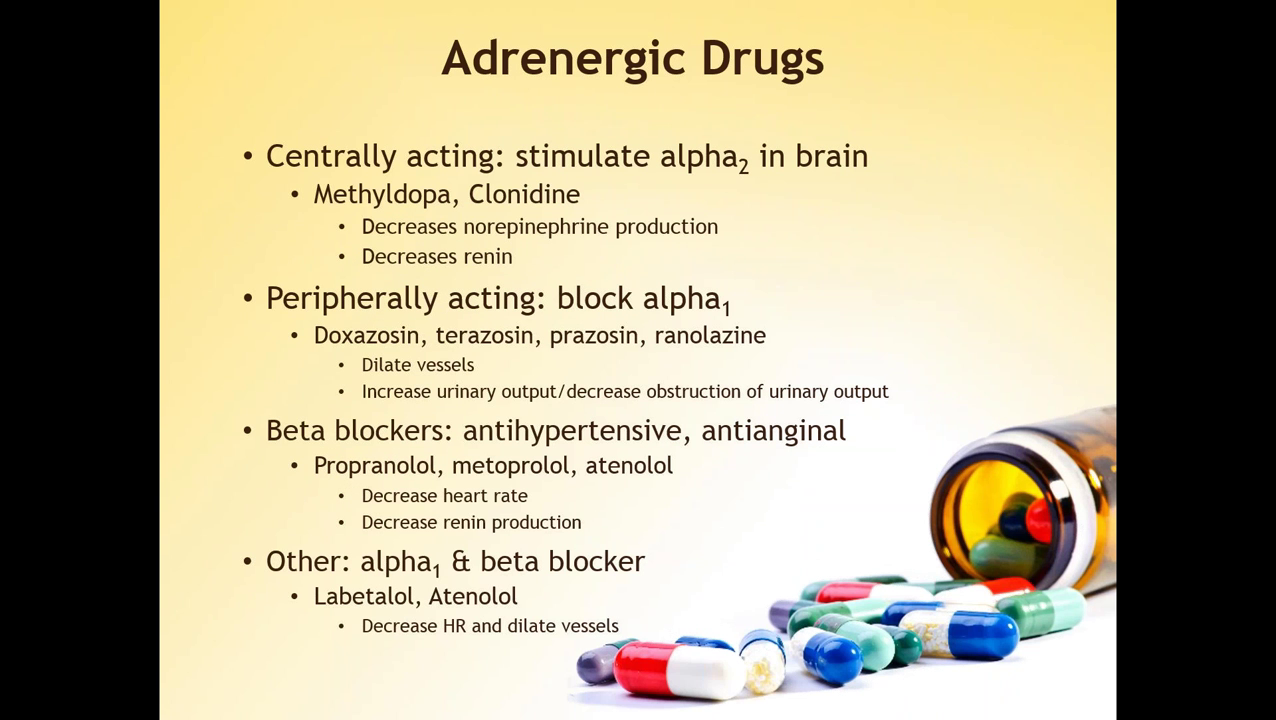
Adrenergic drugs should not be used on patients with acute heart failure, MAOI’s, peptic ulcer, severe liver, or kidney dysfunction. Adrenergic drugs can be used with cardiacglycosides and diuretics to treat severe heart failure. Adrenergic drugs should not be abruptly discontinued because they can have bound hypertensive effect.
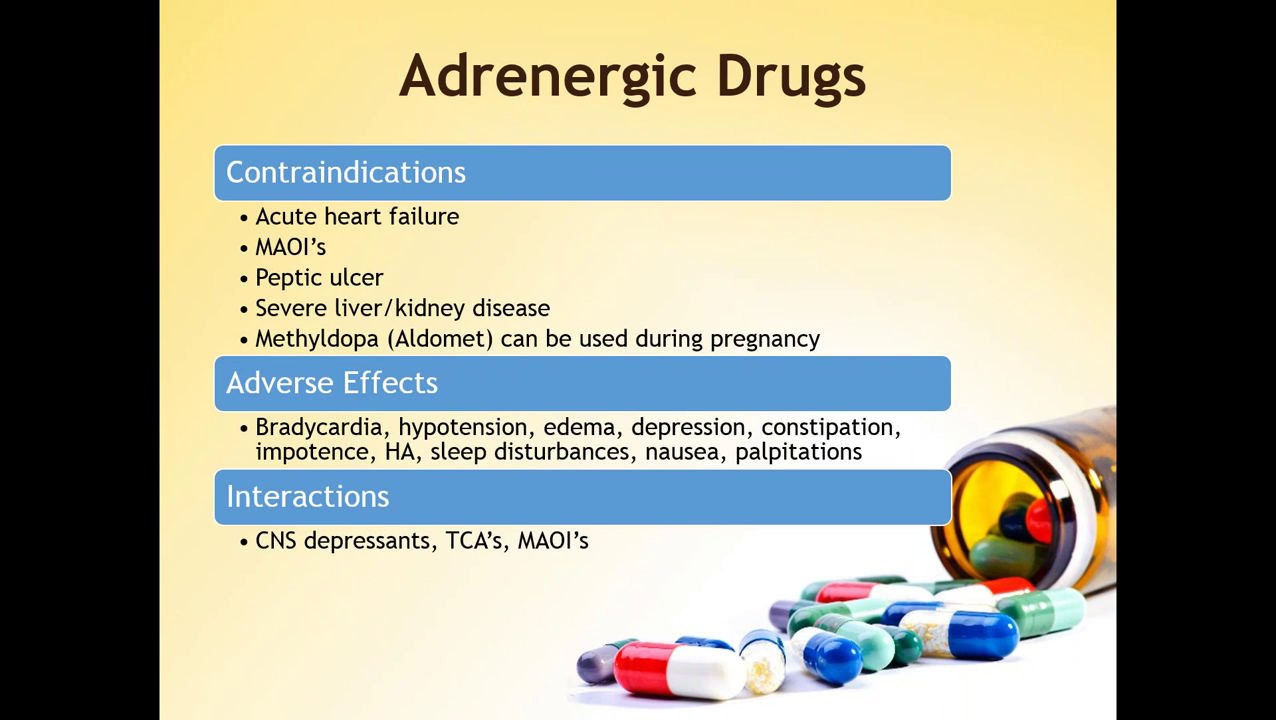
Calcium channel blockers promote muscle relaxation and vessel dilation. These medications decrease actual load causing a lower workload, which means that less work will be needed by the heart. Calcium channel blocker can also be used to treat cardiac dysrhythymias, and they also reduce myocardial contractility. This means that there is lowered heart rate.
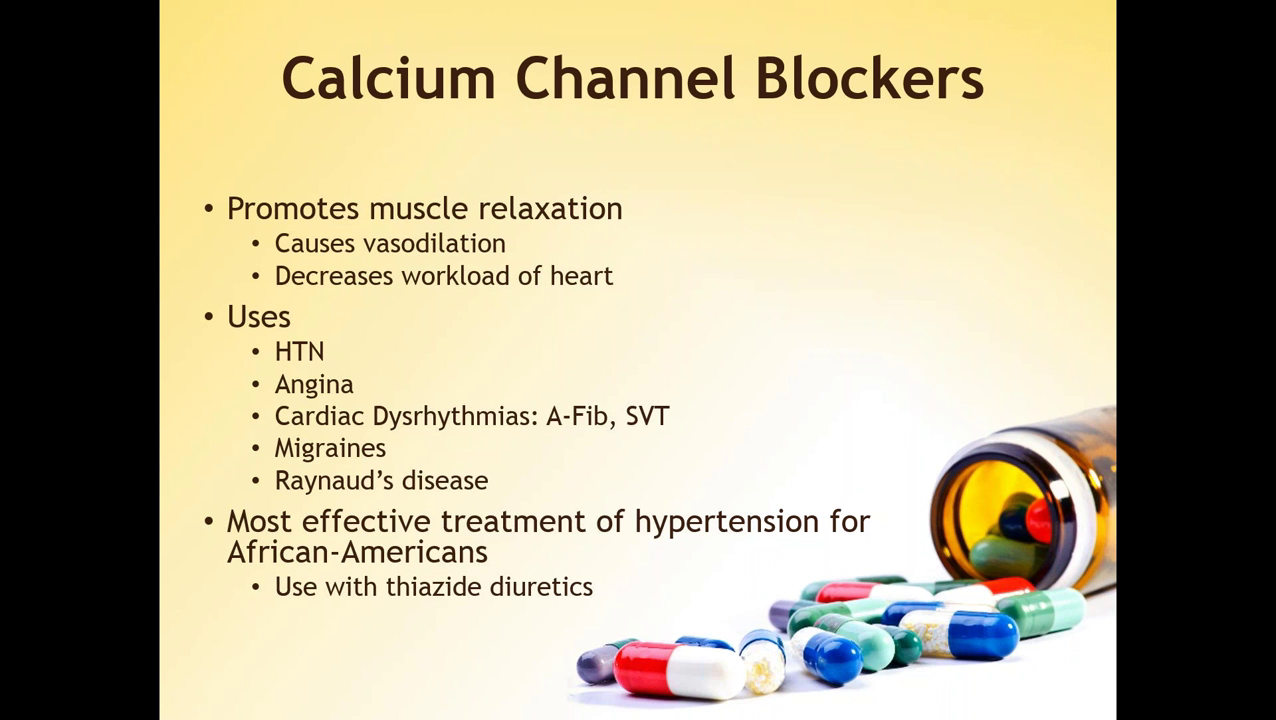
Other conditions that calcium channel blockers can treat include angina, hypertension, SVT, renal disease, as well as other abnormalities. Calcium channel blockers are drug of choice among African American taken with diuretics and thiazides. Other common drugs in this classification include Amlodipine and Celodopine. Calcium channel blockers do interact with grapefruit juice, which reduces their effectiveness. They also interact with beta blockers, Digoxin, and Amiodarone. Due to the side effects of calcium channel blockers, it is important to check pressure of the patient prior to their administration. If a patient has lower blood pressure, the medication should not be provided, and the primary healthcare provider should be contacted. Moreover, calcium channel blockers should not be given with head abscess as they can cause hypercalcemia.
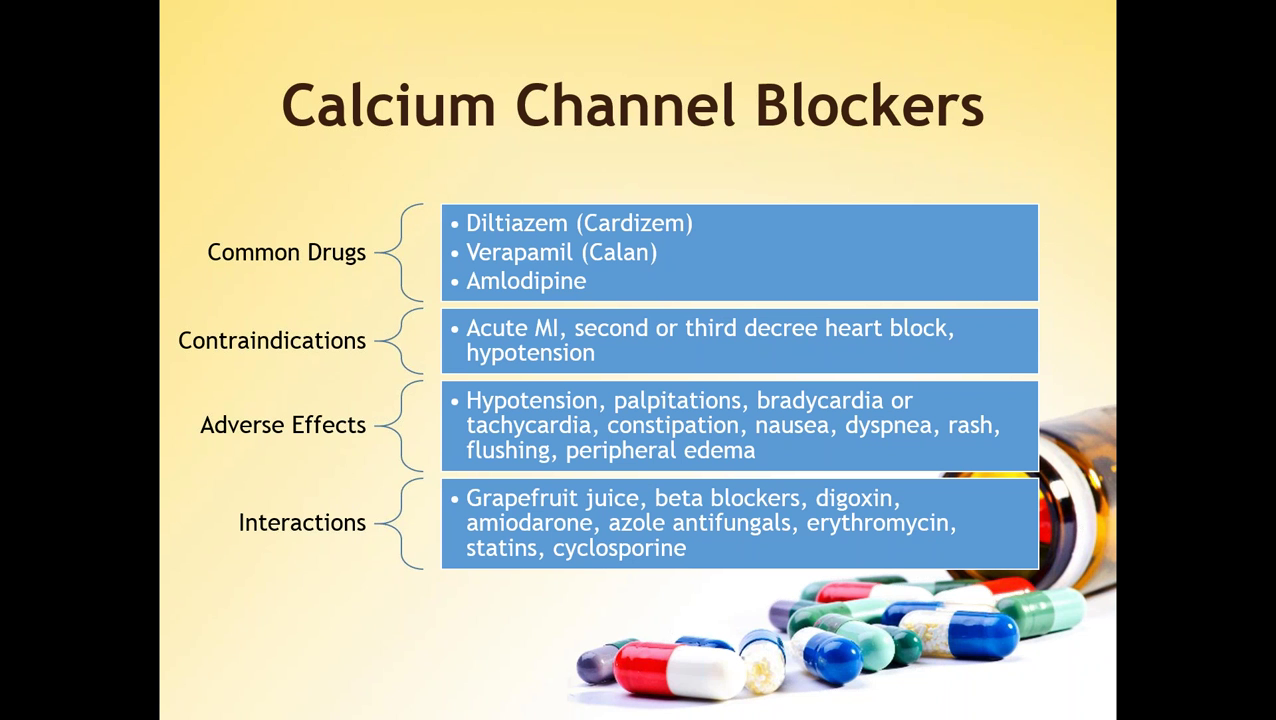
The reason vasodilators allow muscles to venous and/or arteriolar muscles smooth muscles to relax. This in turn causes reduction in the systemic vascular resistance and hypotension. Most commonly used vasodilators are hydralazine and nitroprusside. Nitroprusside is used for hypertensive crisis where the blood pressure is severely elevated. Hydralazine is used to treat primary hypertension. It can be given through IV or orally. It should not be used in coronary artery disease or mytrovalve functioning.
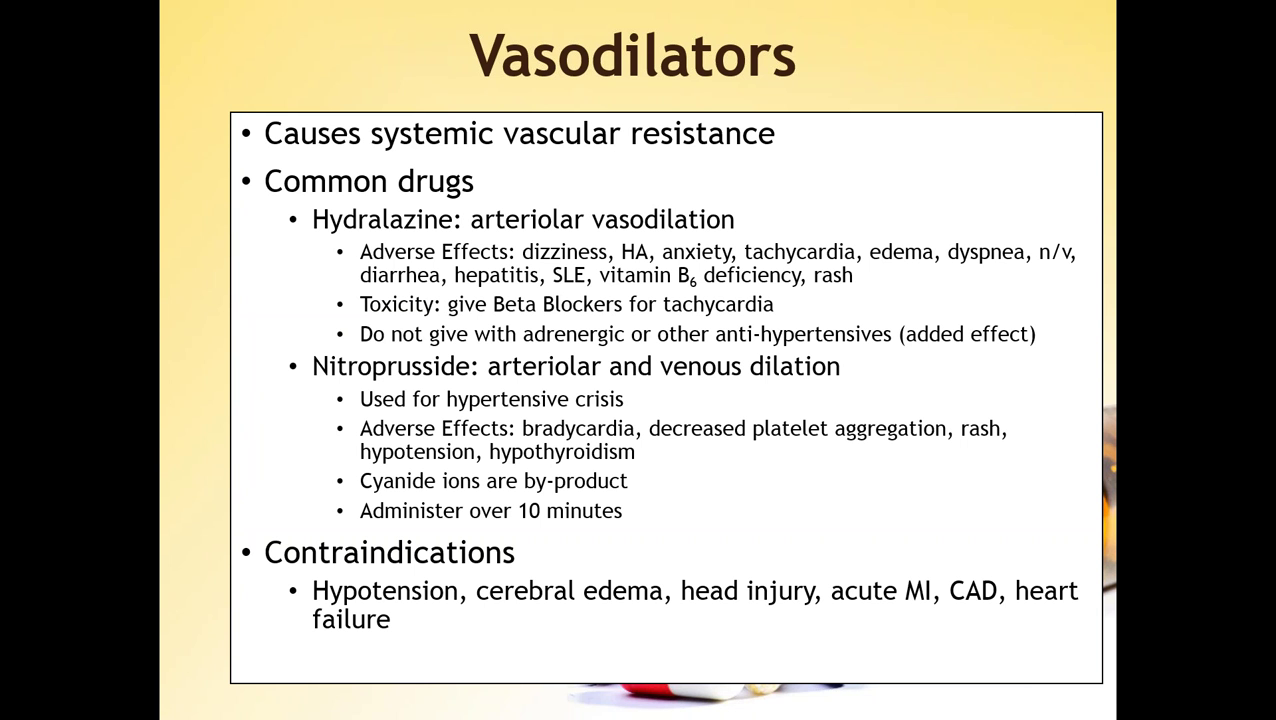
You have to assess blood pressure before administering these medications. If the blood pressure is less than 90mmHg systole and/or less than 60mmHg diastole, do not administer this medication and notify the provider. You also want to assess heart and lung sound before entering therapy.
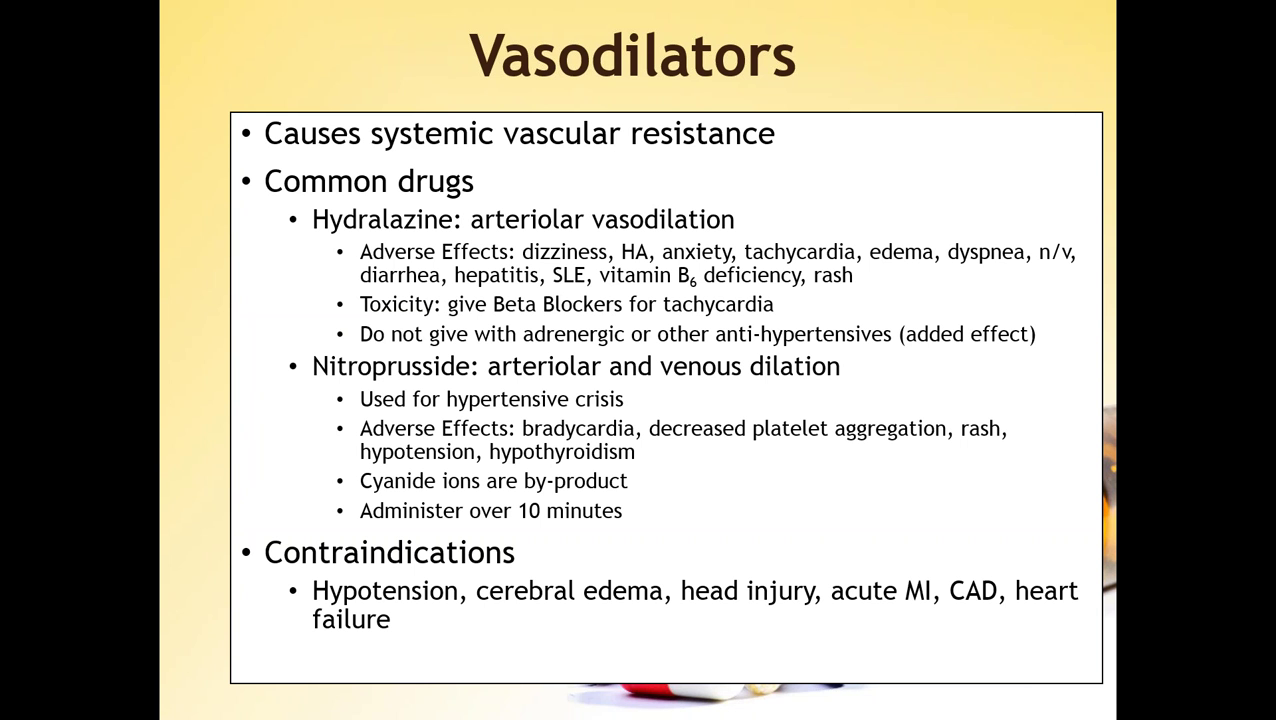
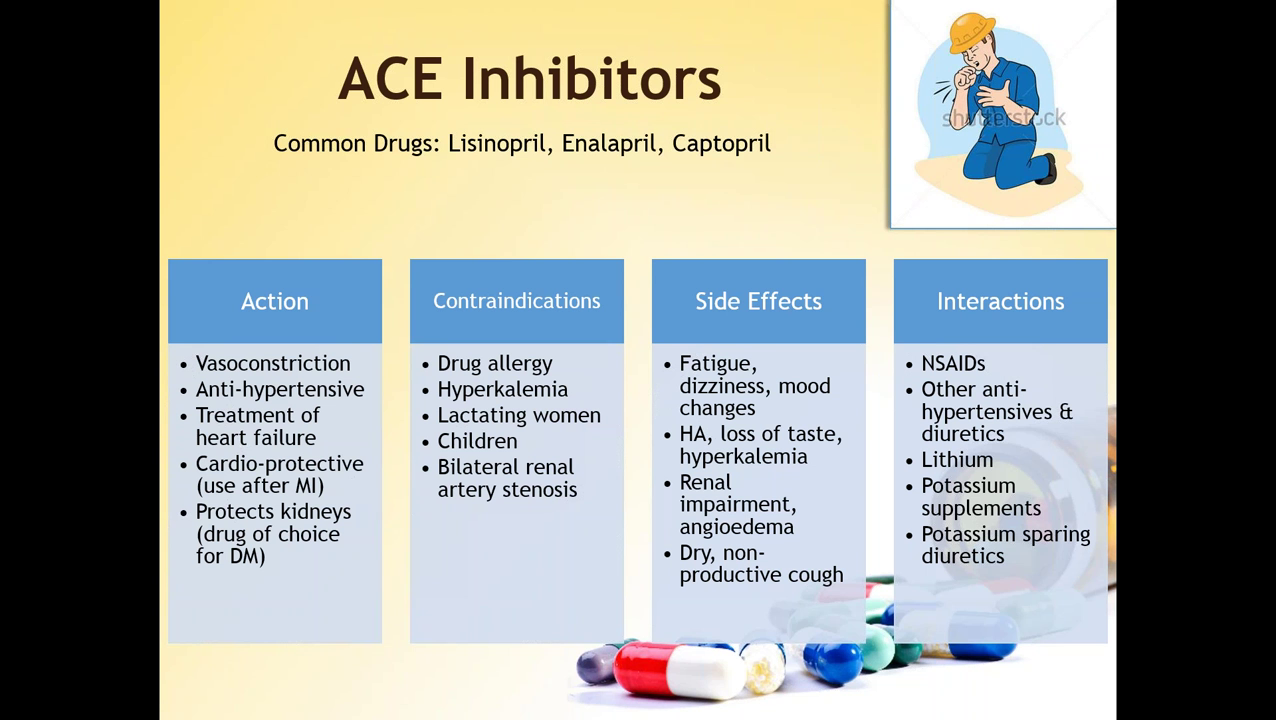
ACE inhibitors are group of anti-hypertensive medications containing 10 different types of medications. Often times, thiazide, diuretics, and calcium channel blockers may be combined with ACE inhibitors to increase compliance. ACE inhibitors are often first line drugs for treating heart failure and hypertension. Captopril is one of those ACE inhibitors with the shortest half-life, so it is going to be dosed more frequently than other ACE inhibitors. Enalapril is also dosed multiple times a day. Captopril unlike Lisinopril is not a pro-drug. A pro-drug is a drug that is inactive when administered, and must be metabolized to active form in the body. Usually, this is done in the liver. This characteristics has advantage to other anti-hypertensive, in that, they are not dependent on the liver in order to activate this drug.
ACE inhibitors are not safe to be given during pregnancy due to the detrimental effects they can have on the fetus.
ACE inhibitors may be used in conjunction with diuretics between hypertension and heart failure, and they are excellent drugs after MI.
ACE inhibitors are preferred for diabetic patients as they protect kidneys and help to prevent diabetic nephropathy.
ACE inhibitors should not be used with lactating women with children and with patients that have bilateral renal artery stenosis.
ACE inhibitors promote potassium re-absorption, for this reason potassium levels need to be monitored ACE inhibitor may cause postural hypotension, so you should take blood pressure and pulse prior to administration, and educate your patient to take slowly to decrease hypotensive effects.
ACE should not be taken with NSAIDs or potassium supplements. Potassium being diuretic should not be given with ACE inhibitors.
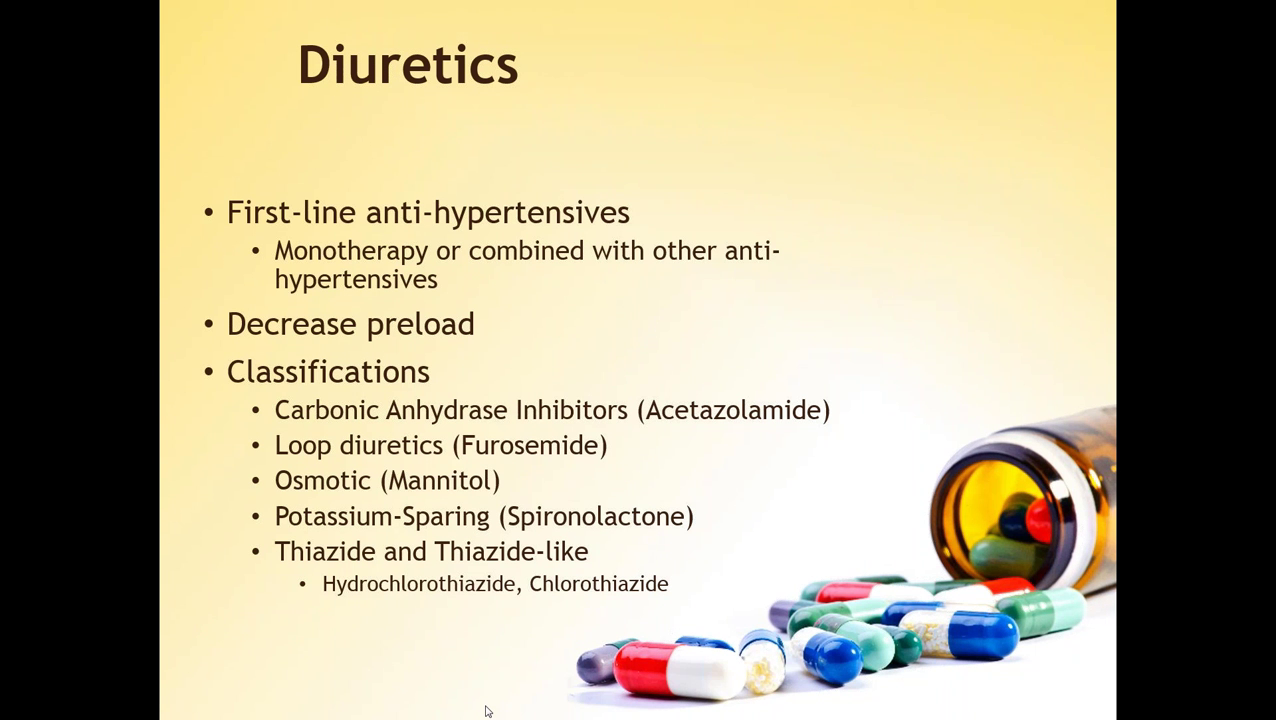
Diuretics are very effective in reducing blood pressure by decreasing the cardiac output and peripheral resistance. This reduces preload, thus reducing workload of the heart. Diuretics are the first line therapy for reducing blood pressure, and can be used with other hypertensive drugs to manage hypertension.
Carbonic anhydrase inhibitors are used commonly to prevent the reabsorption of sodium and water, and to reduce the formation of hydrogen ions and bicarbonate ions from carbon dioxide and water. This can reduce development of the respiratory and metabolic acidosis.
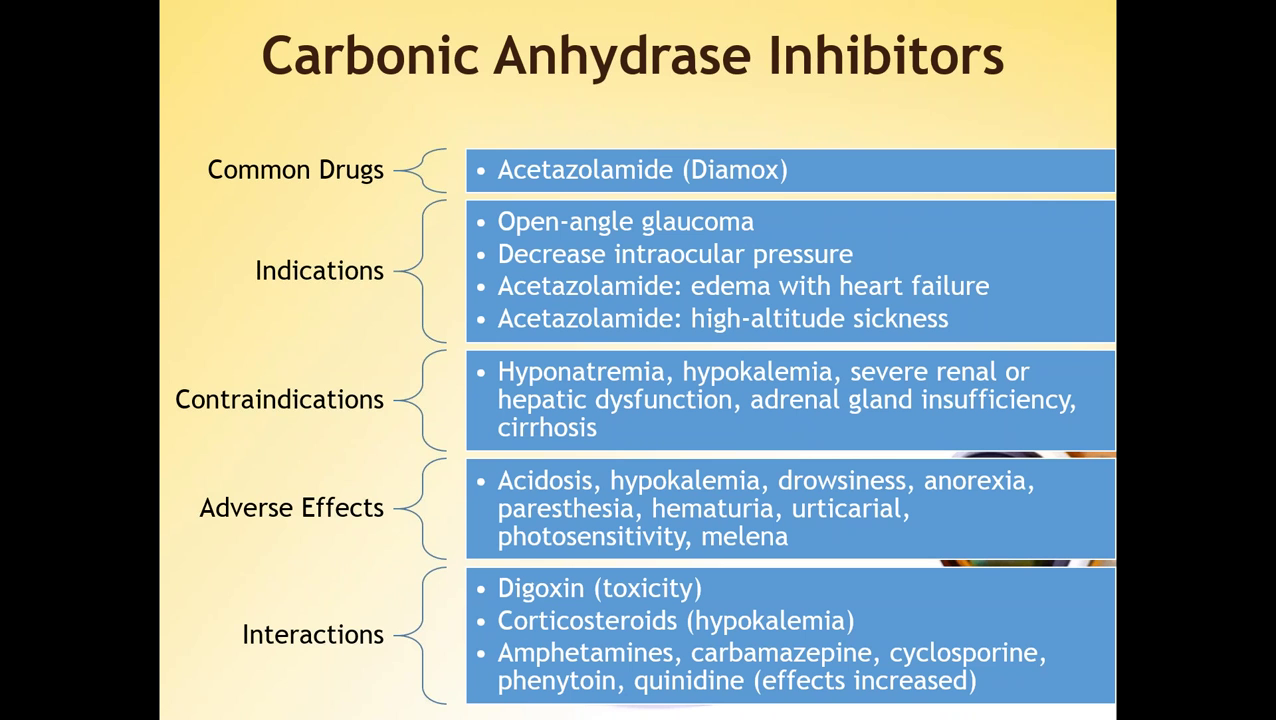
Carbonic anhydrase inhibitors can increase blood glucose levels due to the potassium that is lost in the urine. Carbonic anhydrase inhibitors can cause hypokalemia and acidosis. Because of hypokalemia, the drug toxicity might occur if these medications are combined. Due to the adverse effects of CAIs, it is important to monitor electrolyte levels. Diabetics may need to adjust their influence dosage due to increase in blood glucose levels. Do not give Digoxin with CAIs because Dogoxin toxicity can result.
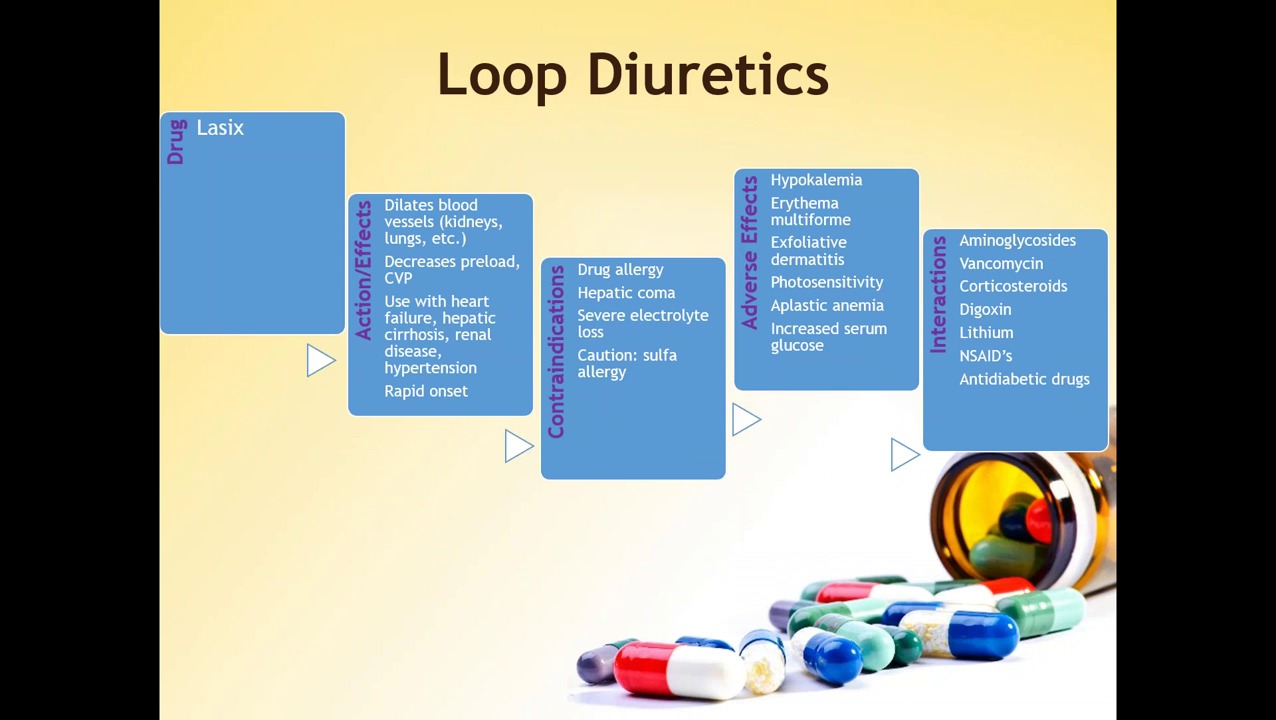
Loop diuretics are very potent and act very quickly. Lasix (Flurosemide), is a common loop diuretic that affects kidneys and heart. It is a preferred diuretic with those with renal dysfunction, but prolonged use can cause toxicity. There is a significant loss of sodium and potassium with the use of loop diuretics. So, loop diuretics should be used with caution in older adults due to the potential of causing electrolyte imbalance and dehydration. Loop diuretics have contraindication when used with aminoglucosides, vancomycin, corticosteroids, digoxin, lithium, NSAIDs, and anti-diabetic drugs.
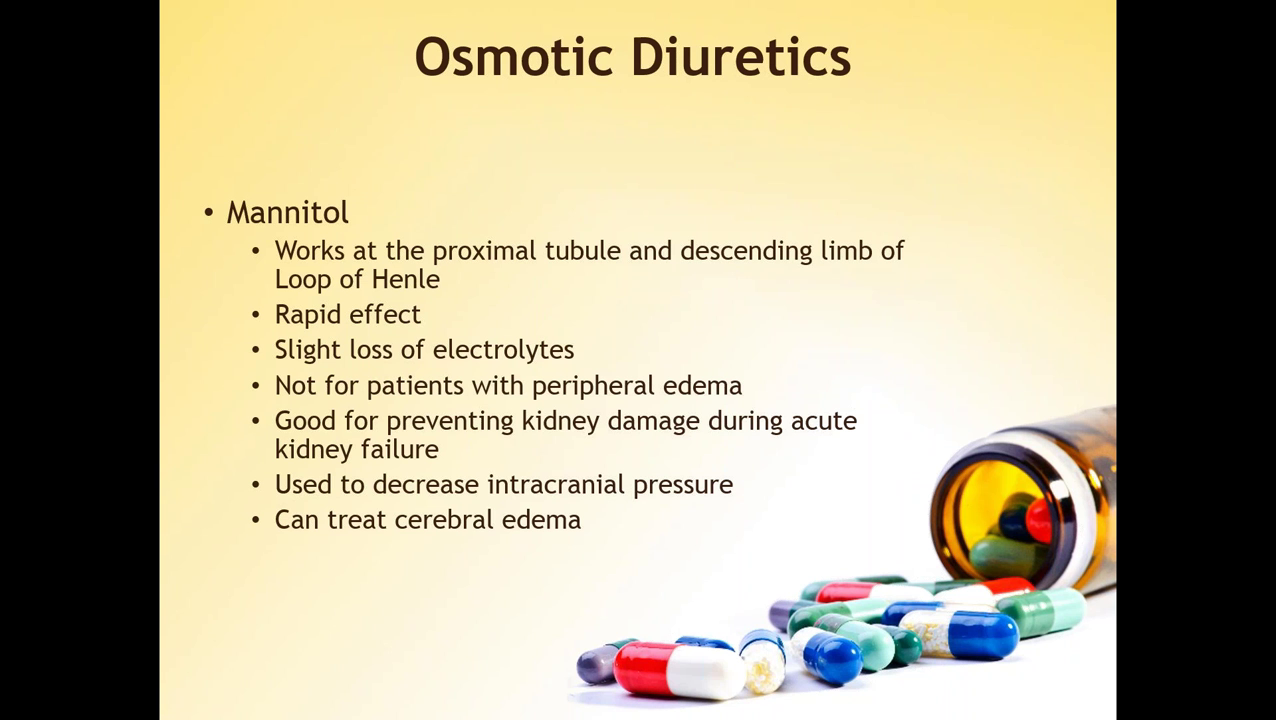
Mannitol is an osmotic diuretic. It is preferred diuretic to use with celebral oedema. There is very little electrolyte loss with osmotic diuretics. Therefore, it is not very effective with peripheral diuretics. Mannitol causes vasodilatation; hence, it is not good for patients with acute kidney damage.
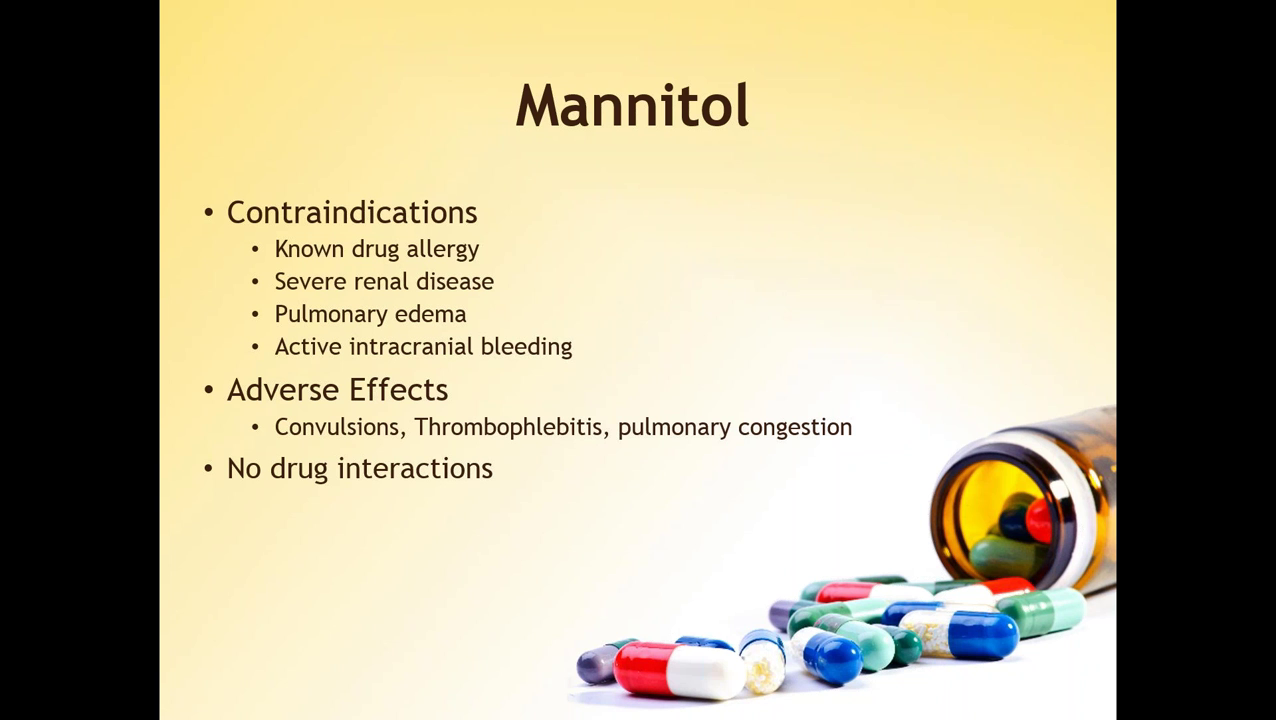
There are no drug interactions with Mannitol
Mannitol is administered via IV, but since it can crystallize at low temperature, it should be administered with a filter.
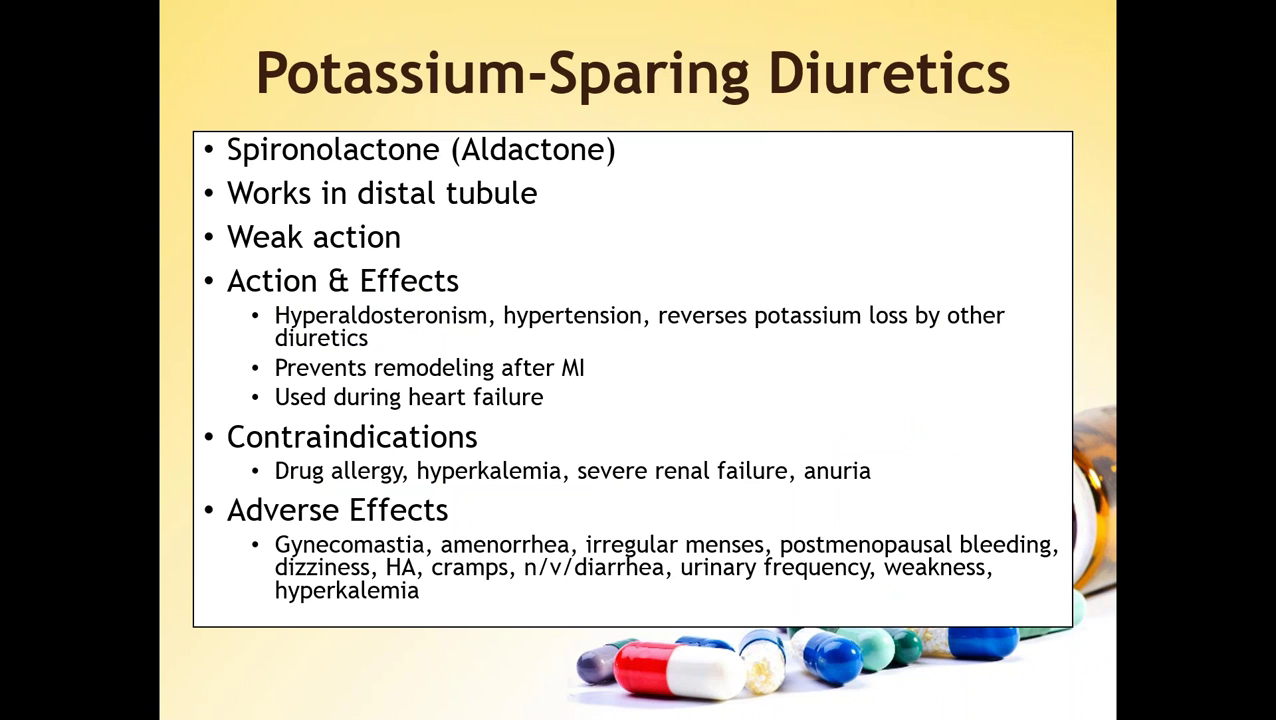
Potassium-sparing diuretics inhibit aldosterone receptors.
Sodium and water are excreted while potassium is retained
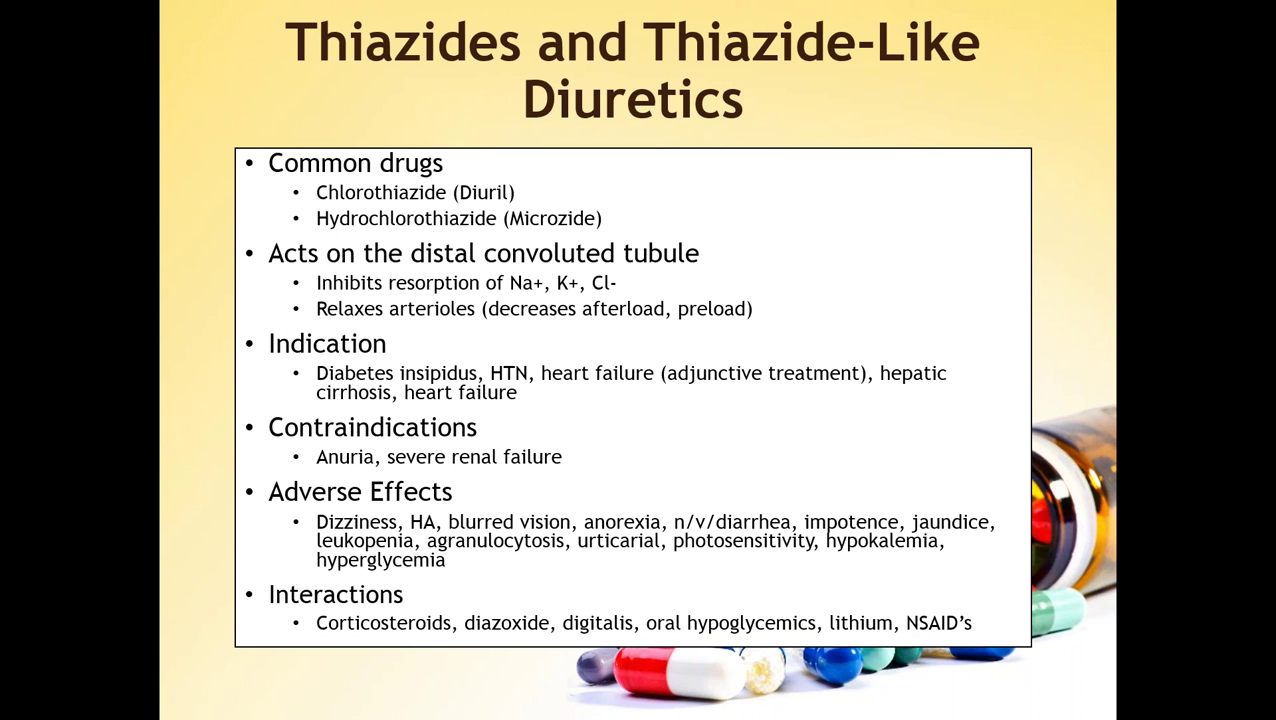
Thiazides such as Diuril and Microzide are the most commonly prescribed due to low costs.Thiazides can treat oedema that develop due to heart failure as well as other conditions.Thiazides can cause electrolyte imbalance that can result in digitalis toxicity. With all diuretics, you need to ascertain when a patient should take them daily at the same time every day. Constipation can result from potential dehydration.
All diuretics should be taken in the afternoon or in the morning to prevent nocturia, which can result in disturbed sleep patterns. In the case of nausea and vomiting, diuretics should not be given and the healthcare provider should be notified.
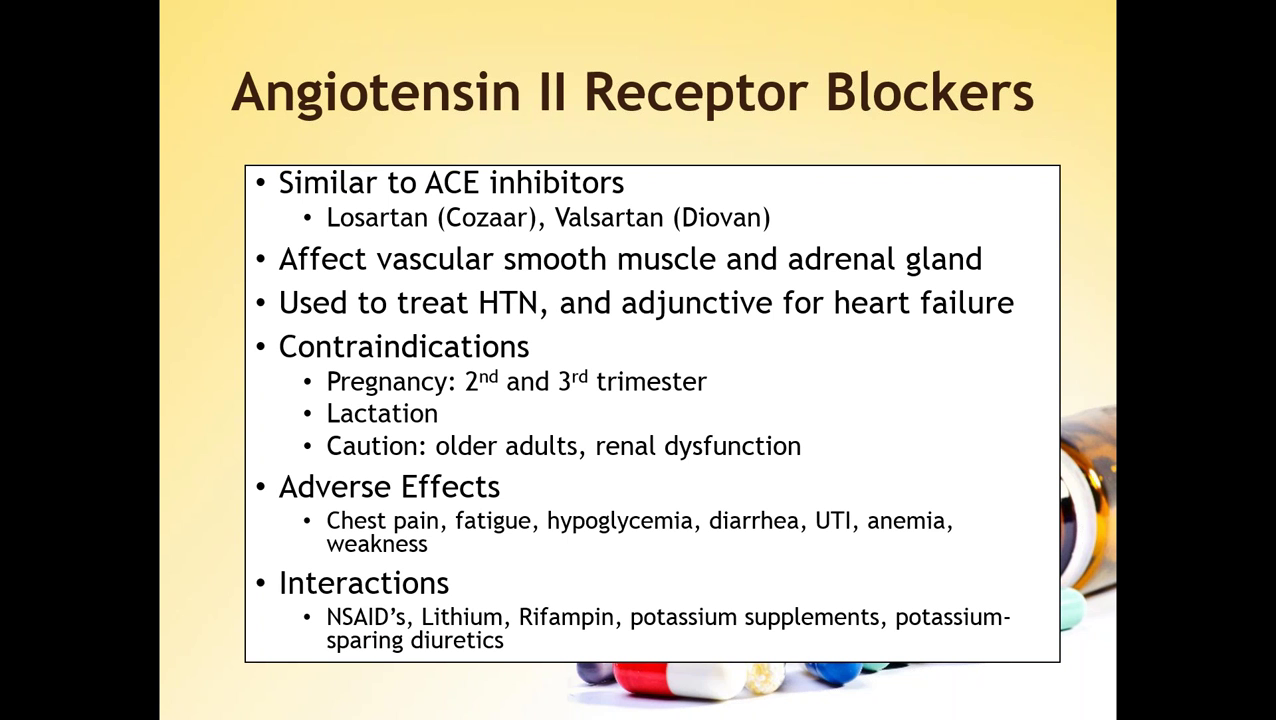
Angiotensin II receptor blockers (ARB) affect the breakdown of kinin similar to ACE inhibitors. RRB, ACE inhibitors, and beta blockers are the first line treatment for heart failure. Note that, all anti-hypertensives can cause sexual disorders such as impotence.
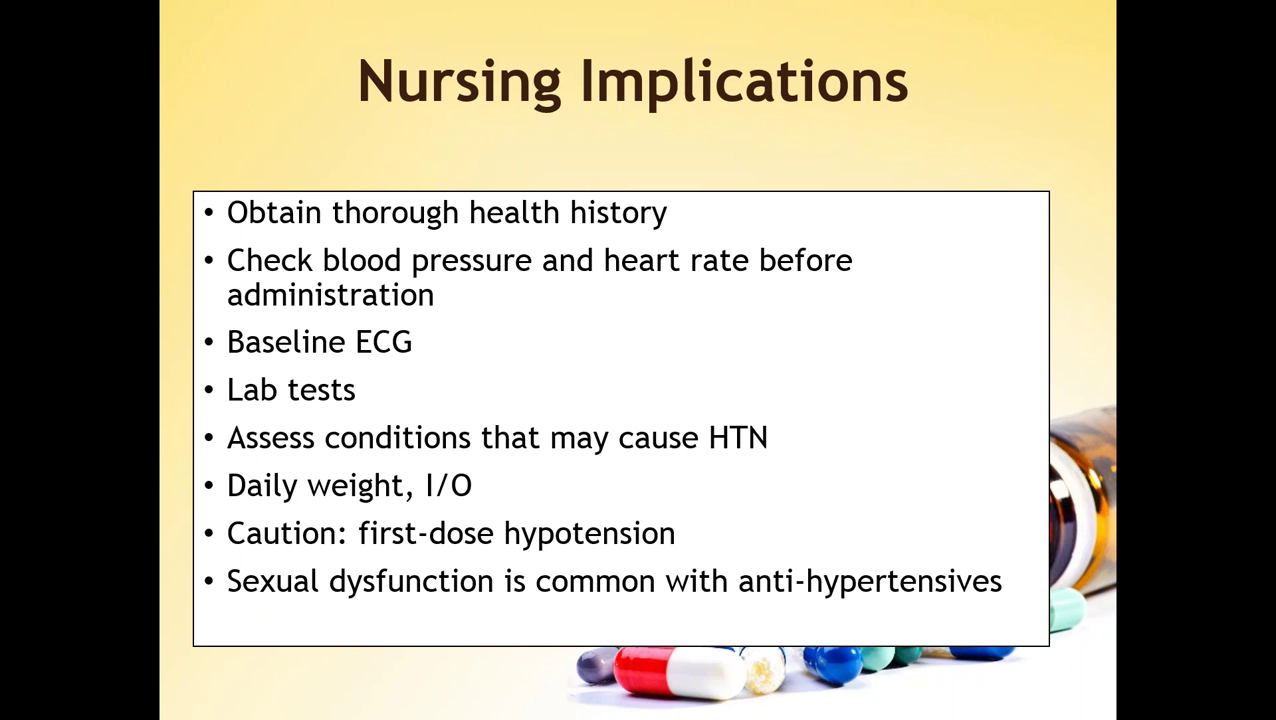
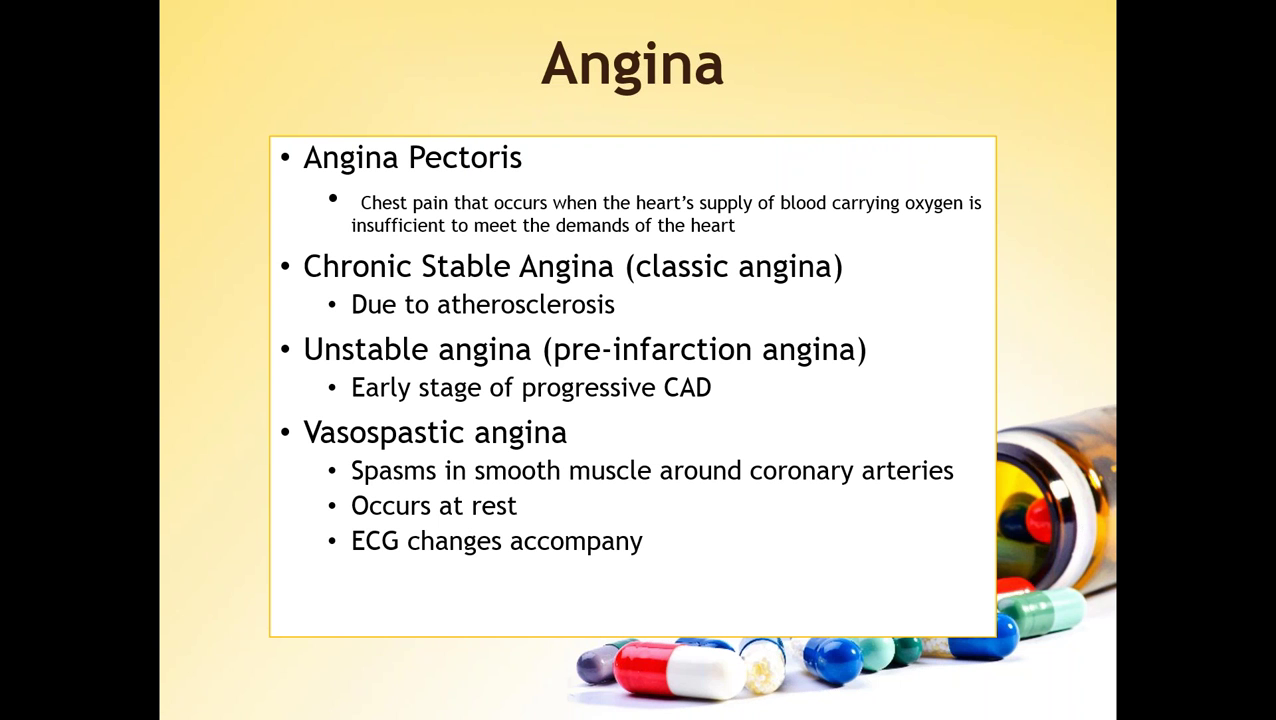
There are several types of angina. Stable angina is a chest pain that occurs due to an activity that is relieved at rest and/or administration of nitroglycerin. Unstable angina occurs due to the acute coronary syndrome, which takes at least 10 minutes. Vasospastic angina is spasms that occur at the coronary artery that is brought by stress, cold weather, or cocaine use.
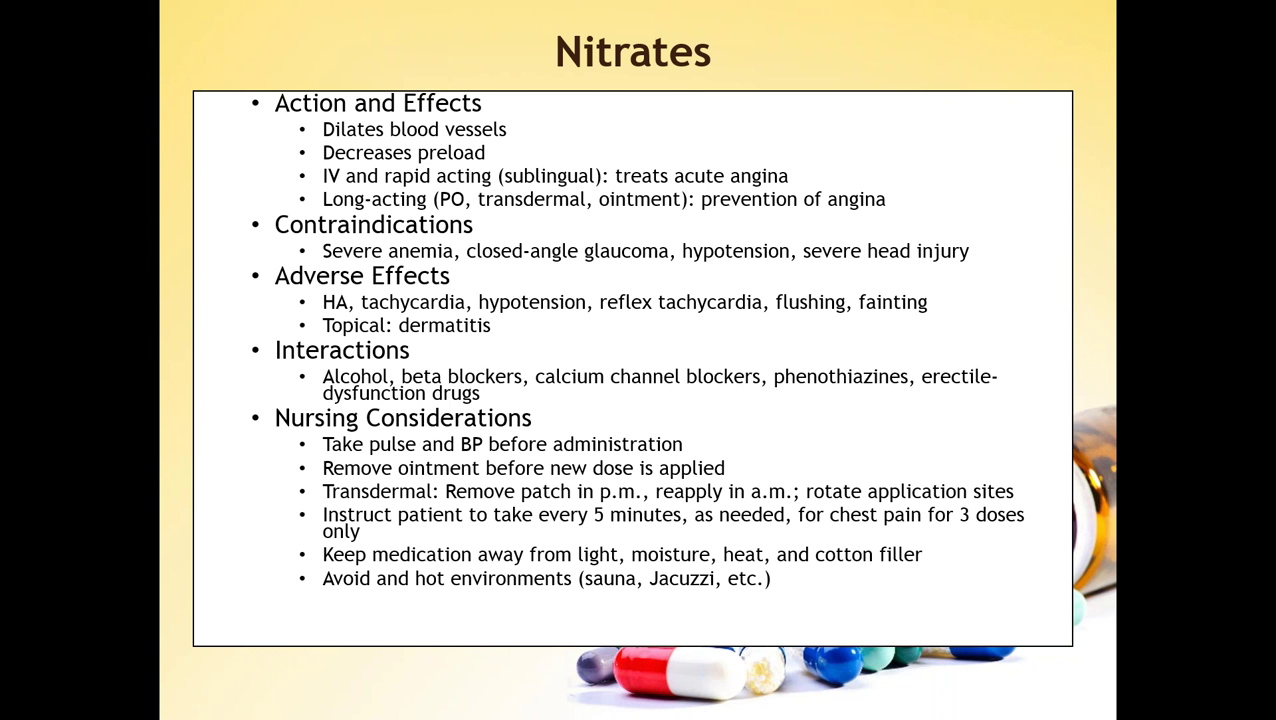
Nitrates are used to treat angina and other cardiac problems
Nitrates can be given sublingually, orally, topically, translingual spray or through IV.
Rapi acting nitroglycerin can be used to treat acute angina. It is best used sublingually by placing under the tongue. If acute angina is not relieved, the patient should be instructed to call 911and the second tablet be given 5 minutes after the first. No more than three nitroglycerin tablets should be taken. When using a topical or patch, remember to locate the site, making sure to assess skin for nay irritation, cleanse the area for individual medication before re-applying.
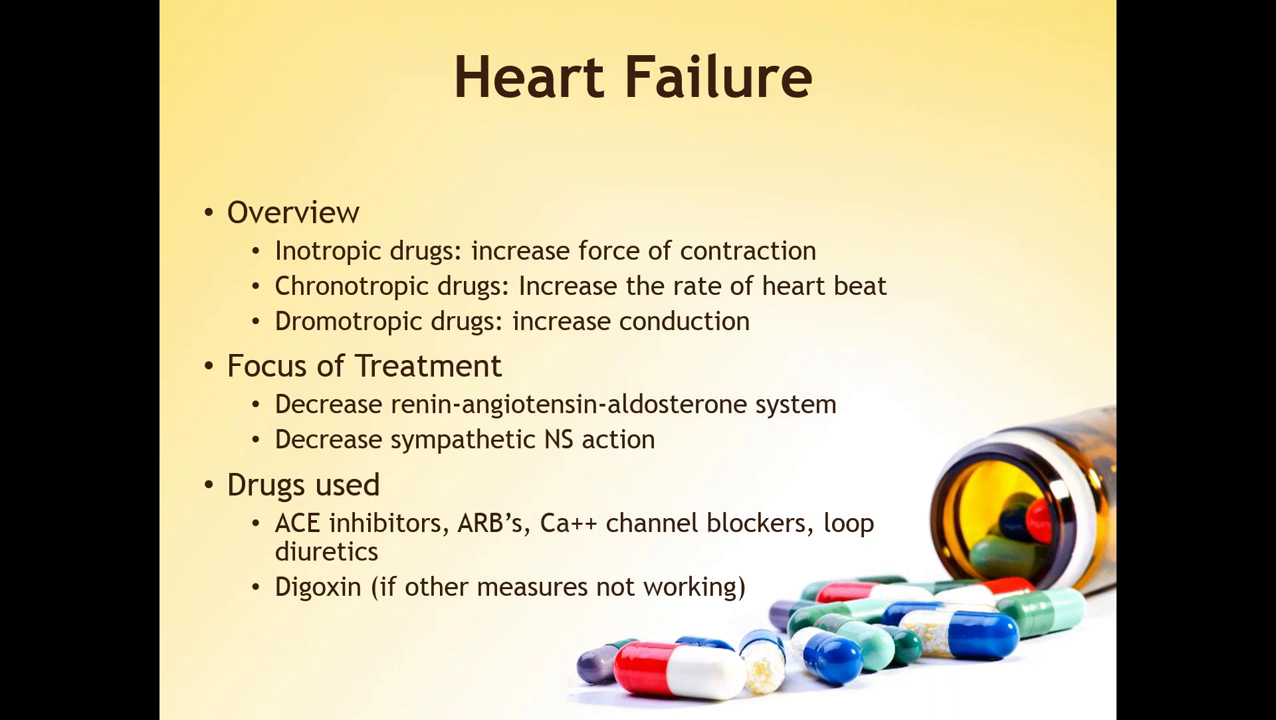
Drugs that treat heart failure can be inotropic, chronotropic, or dromotropic. Drugs that increase the force of myocardial contraction are said to have positive inotropic effect. Drugs that increase heart rate are said to have positive chronotropic effect. Drugs that accelerate conduction are said to have positive dromotropic effect. Drugs used to treat heart failure are ACE inhibitors, ARB’s, calcium channel blocker, and loop diuretics. Digoxin can also be used when all other measures are ineffective
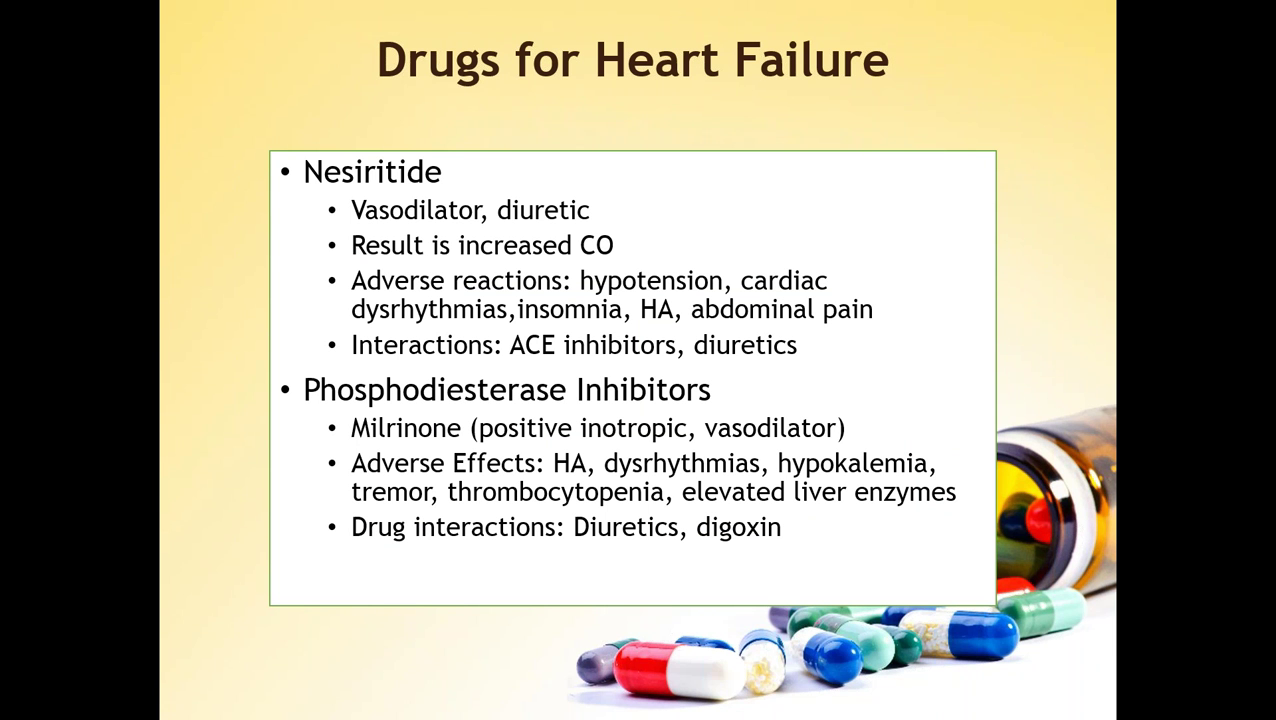
Nisiritide is used to treat decompensated heart failure. This causes vessel dilation and dieresis. It is used in severe heart failure and is given IV in hospital settings. When given through IV, check for interactions with other medications
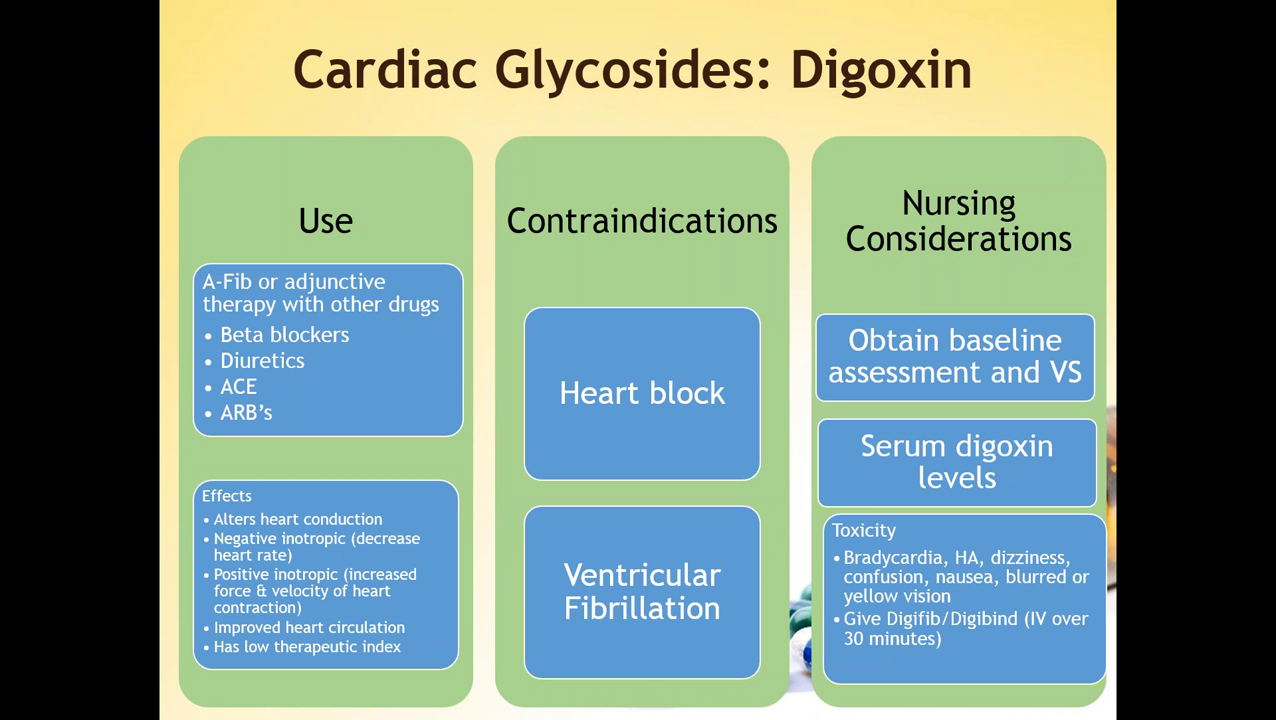
Cardiac glycosides are like Digoxin are used to treat ventricular fibrillation and systemic heart failure. It is often used with other anti-hypertensives. Digoxin has a positive inotropic effect resulting in a more effective contraction of the heart. Digoxin reduces heart rate and increase the stroke. Before administering Digoxin, be sure to check e client’s heart rate, it the heart rate is below 60, do not administer, and notify the healthcare provider. Digoxin has a low therapeutic index, and therefore, Digoxin levels must be checked. Signs of Digoxin toxicity are headache, confusion, nausea, and blurred vision. Digoxin toxicity can cause dysrhythmia and is treated with Digoxin immune fab therapy (digibind). Digibind can only be used with acute Digoxin toxicity, and it is given through IV. Hypokalemia can increase a patient risk for Digoxin toxicity, and therefore, electrolyte leves requires constant monitoring.
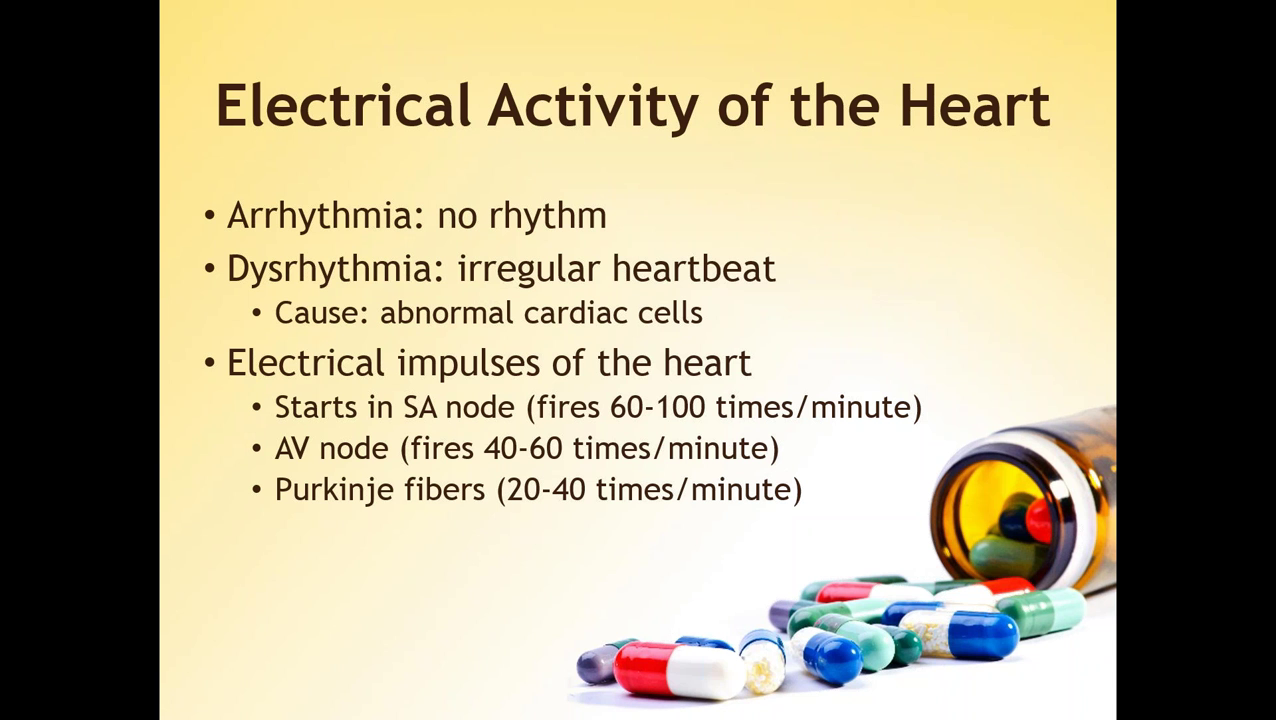
Dysrhythmia is an irregular heartbeat
All anti-hypertensive medications are capable of causing dysrhythmia
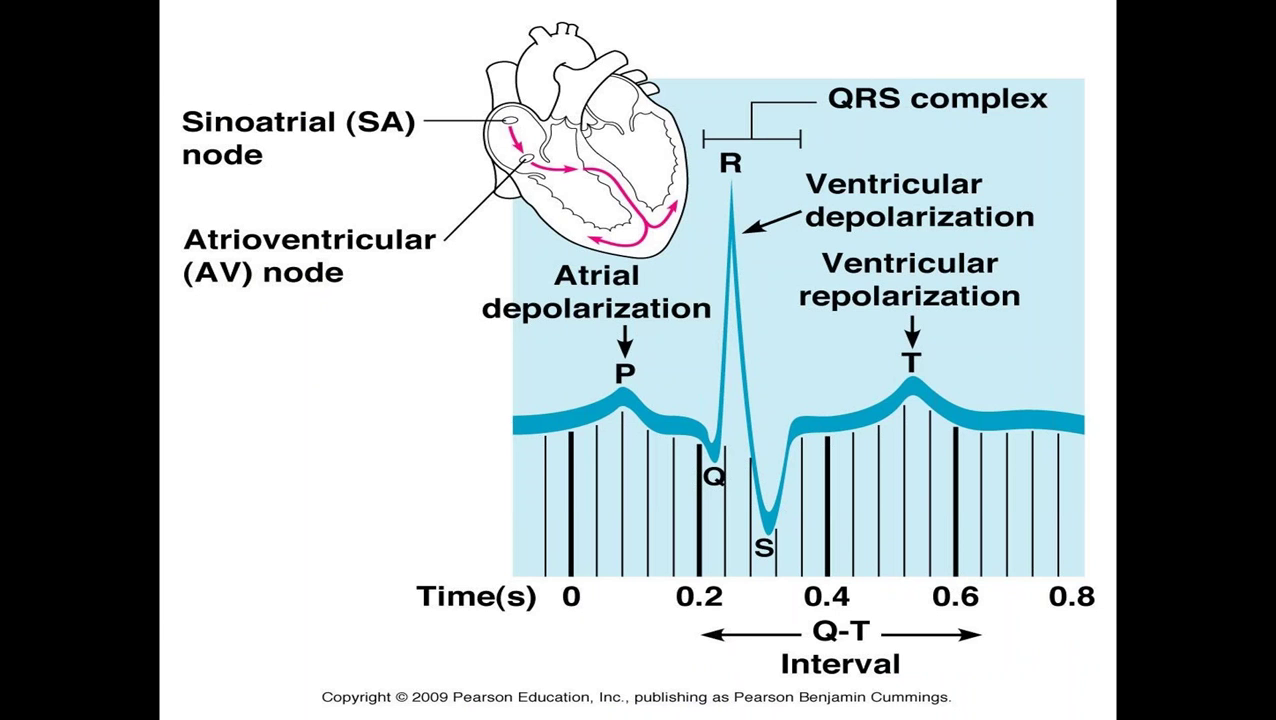
The electrical activity begins in the SA node, and then, from there it travels to AV node. From AV node, electrical impulse travels to Purkinje fiber.